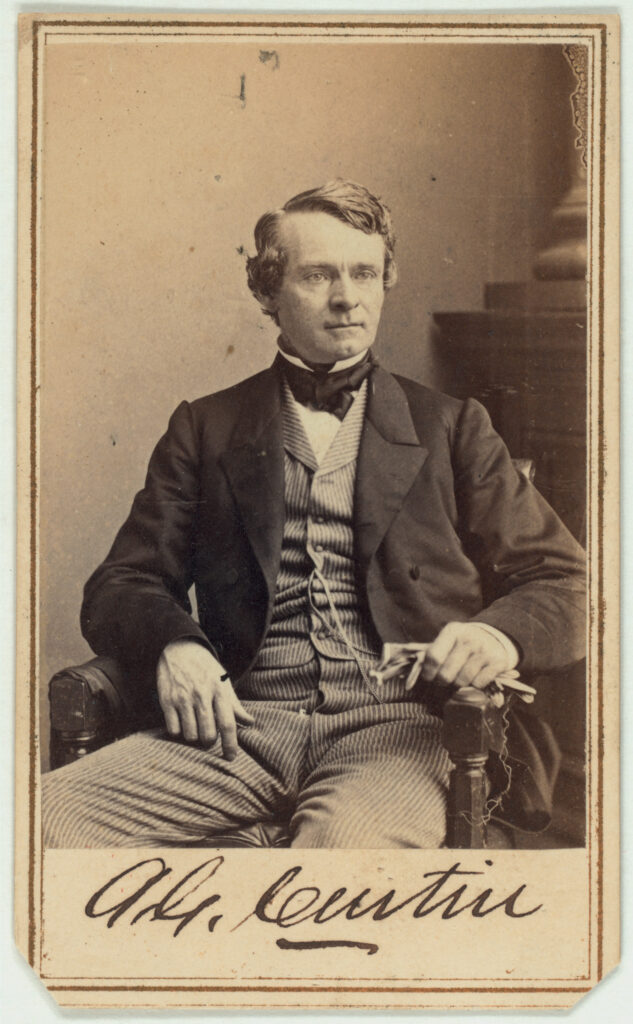Andrew Gregg Curtin was the governor of Pennsylvania during the Civil War and one of President Abraham Lincoln’s staunchest supporters.
Curtin was born in Bellefonte on April 22, 1815. His father, Roland Curtin, owned the Eagle Ironworks, and his mother, Jane Gregg, was the daughter of U.S. Senator Andrew Gregg, Curtin’s namesake. Curtin attended Bellefonte Academy and studied law at the Dickinson School of Law. He married Katharine Irvine Wilson in 1844, and they had five children.
Curtin practiced law in Bellefonte with John Blanchard. He gained a reputation as an excellent orator and began campaigning on behalf of Whig Party candidates, including James Pollock, who was elected governor of Pennsylvania in 1854. Pollock appointed Curtin as Secretary of the Commonwealth and Superintendent of the Common Schools.

By 1860, Curtin was a member of a “People’s Party,” whose members were Republicans aligned with Whigs and Democrats who favored some Republican policies. Curtin defeated Democrat Henry D. Foster in the 1860 gubernatorial election after running as a conservative Republican who emphasized the preservation of the Union and support for the soldiers.
Immediately after the Civil War began, he started enlisting troops in the Union Army. Camp Curtin opened near the state capitol in Harrisburg, and more than 300,000 troops drilled there during the war, more than at any other recruiting point in the North. Curtin visited the White House several times to consult with the president.
After Union defeats on the battlefield led to harsh criticism of Lincoln, Curtin hosted the Conference for Governors of the Loyal States in Altoona in September 1862. The fourteen governors who attended the conference passed a series of resolutions supporting the president and the Union cause. In the stress of the war, Curtin suffered a nervous breakdown, but he was re-elected governor in October 1863, defeating Democrat George Woodward.
Curtin’s interest in the troops in the field earned him the name “The Solder’s Friend.” He founded a state-funded school to educate orphans of Pennsylvania troops who died during the war. After the 1863 Battle of Gettysburg, Curtin was a leader in establishing a National Cemetery at Gettysburg. He sat on the platform with Lincoln when the president dedicated the cemetery with his memorable speech that became known as the Gettysburg Address.
After leaving office in 1867, Curtin sought election to the U.S. Senate in 1869 but lost the Republican nomination to Lincoln’s Secretary of War and longtime political rival, Simon Cameron. As a consolation, President Ulysses S. Grant appointed Curtin as minister to Russia. He served for three years but was disillusioned by the corruption of the Grant administration.
Curtin became a Democrat and supported Grant’s opponent, Horace Greeley, in the 1882 presidential election. In 1881-87 Curtin served three terms in the U.S. House of Representatives. After leaving office, he returned to Bellefonte.
Curtin died on October 7, 1894, and was buried at the Union Cemetery. A statue of Curtin is part of the Soldiers and Sailors Memorial, dedicated in front of the Centre County Courthouse in 1906.
Ford Risley
Sources:
Egle, William H. Life and Times of Andrew Gregg Curtin. Philadelphia: Thompson Publishing Co., 1896.
Furniss, Jack. “Andrew Curtin and the Politics of Union,” Pennsylvania Magazine of History and Biography” 141 (April 2017): 145-176.
“Governor Andrew Gregg Curtin,” Pennsylvania Historical & Museum Commission.
First Published: March 10, 2021
Last Modified: September 1, 2024
